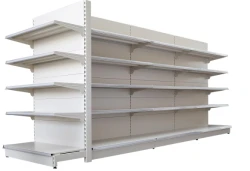Types of Metal Storage Shelving
2024-06-21
Metal storage shelving refers to shelving units or systems made predominantly from metal, designed for organizing and storing various items in residential, commercial, industrial, or institutional settings. These shelves are known for their durability, strength, and versatility. Here’s an overview of metal storage shelving, its types, features, and common applications:
Types of Metal Storage Shelving:
1. Steel Shelving:
- Description: Made from steel components, often with adjustable shelves that can be reconfigured to accommodate different storage needs.
- Features: Sturdy construction, capable of holding heavy loads. Available in various heights, widths, and depths.
2. Wire Shelving:
- Description: Constructed from metal wires or rods welded together, forming open shelves.
- Features: Lightweight yet strong, allowing for good air circulation and visibility of stored items. Suitable for both residential and commercial use.
3. Industrial Shelving:
- Description: Heavy-duty shelving systems designed for warehouses, factories, and storage facilities.
- Features: Constructed from robust metal materials like steel or aluminum, capable of supporting large quantities of goods and heavy equipment.
4. Garage Shelving:
- Description: Specifically designed for garage storage, often made from steel or metal with powder-coated finishes to resist corrosion.
- Features: Adjustable shelves for storing tools, equipment, and household items. Provides efficient use of vertical space in garages.
5. Commercial Shelving:
- Description: Used in retail stores, offices, and other commercial spaces for displaying products or organizing inventory.
- Features: Stylish designs with adjustable shelves, suitable for showcasing merchandise or storing office supplies and documents.
Features and Benefits:
1. Durability and Strength:
- Metal shelving units are robust and capable of withstanding heavy loads compared to other materials like wood or plastic.
2. Versatility:
- Available in various configurations, including open or closed shelves, with options for adjustable shelf heights to accommodate different storage needs.
3. Corrosion Resistance:
- Many metal shelves are treated with coatings such as chrome plating, powder coating, or galvanization to enhance durability and resist rust and corrosion.
4. Easy Assembly and Maintenance:
- Most metal shelving units are designed for easy assembly with minimal tools required. They are also straightforward to clean and maintain.
5. Safety and Stability:
- Designed with safety features like reinforced corners and sturdy frames to ensure stability and prevent shelves from tipping over.
6. Space Optimization:
- Utilizes vertical space efficiently, allowing for maximum storage capacity without occupying excessive floor space.
Common Applications:
1. Warehouse and Storage Facilities:
- Used for storing inventory, equipment, and supplies in industrial environments where heavy-duty storage solutions are required.
2. Retail Stores:
- Displaying merchandise, organizing stockrooms, and managing inventory effectively in retail settings.
3. Garages and Workshops:
- Storing tools, automotive parts, gardening supplies, and other items in residential garages or commercial workshops.
4. Office Spaces:
- Organizing files, documents, office supplies, and equipment in corporate offices, libraries, and educational institutions.
5. Food Service and Hospitality:
- Storing kitchen equipment, supplies, and inventory in restaurants, hotels, and catering facilities.
Considerations for Selection:
1. Load Capacity:
- Choose shelving units with adequate load capacity to support the weight of items being stored.
2. Dimensions and Configuration:
- Consider the available space and required shelf dimensions to ensure the shelving fits the intended area and meets storage needs.
3. Material and Finish:
- Select the appropriate metal type (e.g., steel, stainless steel, aluminum) and finish (e.g., powder-coated, chrome-plated) based on durability requirements and aesthetic preferences.
4. Adjustability:
- Adjustable shelf heights provide flexibility for storing items of various sizes and shapes.
5. Accessibility and Safety:
- Ensure shelves are easily accessible and consider safety features such as corner guards and stability mechanisms, especially for industrial or heavy-duty applications.
Metal storage shelving systems are essential for efficient organization and storage management across various sectors. By selecting the right type and configuration, these shelving units contribute to improved space utilization, durability, and overall functionality in both residential and commercial environments.



